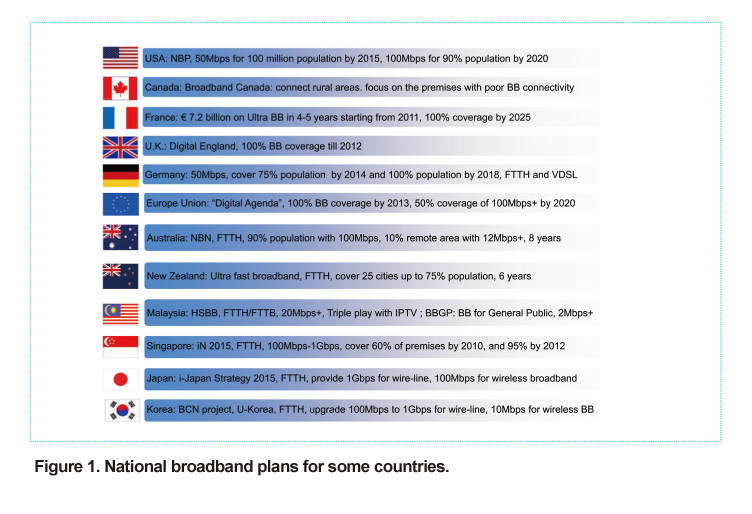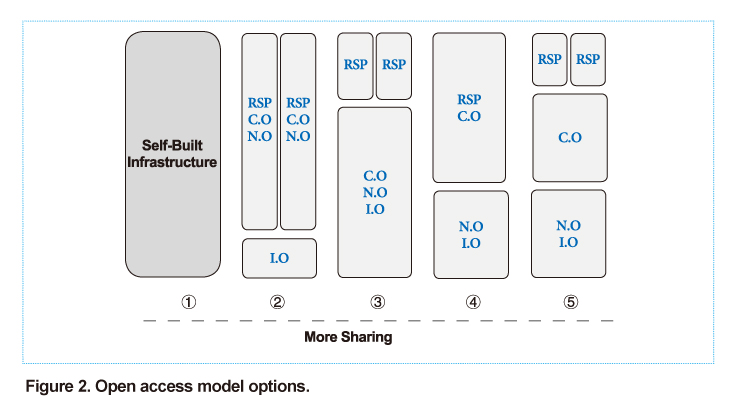Construction of National Broadband Networks
Trends
A national broadband network (NBN) is a country's telecommunication infrastructure and differs from a regular broadband network built by a telecom operator. The backbone of an NBN can be newly constructed or it can be based on the existing network of the country's leading telecom operator. Dedicated networks, such as an e-government network, enterprise network, education network, and military network, can be supplements.
With high-speed Internet access, there is an increasing demand for high-bandwidth HDTV and 3D-TV. This is driving the world’s leading telecom operators to build networks with higher bandwidth. The digital economy will be an important part of the future global economic system as governments seek to develop new industries to stimulate consumption, narrow the digital divide, create employment, and push forward economic recovery. In recent years, there has been an upsurge in NBN construction around the world. Some countries have even published their national strategies for broadband development.
By the end of March 2011, 98 countries and regions had broadband strategies. The US, UK, and Australia have released their specific plans for broadband development that include goals, policies and specific measures. Governments are now playing an increasingly important role in broadband development.

Features
Despite differences in strategic goals, choice of technology, and construction models, NBNs in different countries have some common features.
High bandwidth. A basic requirement of an NBN is to provide ultra-high bandwidth that can cater to the needs of high-bandwidth services into the future. Singapore’s Intelligent Nation 2015 Plan (iN2015) will be put in place by 2012. It will be capable of delivering broadband speeds of up to 1Gbps and offer bandwidth-intensive applications such as video conferencing, video surveillance, streaming media, and HDTV.
Open architecture. An NBN requires open network architecture rather than simple network scale-up. Open network architecture provides an open platform that encourages competition between small- and mid-sized ISPs and CSPs.
Convergence. An NBN must allow for fixed-mobile convergence, interoperability between telecom and private networks, transition from narrowband to broadband networks, and unified scheduling of diverse services.
Environmental friendliness. An NBN is part of a country's long term strategy and must be environmentally friendly.
Construction Model
An open access platform and wholesale business model are fundamental for building an NBN. These help create a fair competitive environment for operators and retail service providers (RSPs) and also offer more options to users.
Open access is a new network construction model. An open access network can be jointly built by network operators, equipment vendors, RSPs and stakeholders. RSPs purchase bandwidth from network operators and compete with each other on the same platform to provide competitive and attractive services for end users. The open access network comprises four layers:
Layer 1: physical infrastructure (including communication pipes, poles and enclosures) that is typically managed by an infrastructure operator (I.O.)
Layer 2: physical fibers that are built and operated by a network operator (N.O.)
Layer 3: active infrastructure (including physical network equipment such as OLTs and ONTs) that is typically built and operated by a communications operator (C.O.)
Layer 4: retail services (including voice, data and video services) that are provided by RSPs.
Open access is widely used for building NBNs. There are five open access models.
Model 1: an operator’s self-built infrastructure―the traditional network buildout model.
Model 2: Portugal and France use this model. In Portugal, the telecommunications regulator, Anacom, makes the open access rules. Physical pipe resources in the network are open. Through competition, the physical infrastructure at layer 1 is leased to each RSP for construction and operation at layer 2, layer 3 and layer 4. In France, ARCEP is the telecommunications regulator. France Telecom builds physical infrastructure and leases it to each RSP for construction and operation at layer 2, layer 3, and layer 4.
Model 3: The UK uses this model. The UK telecommunications regulator, Ofcom, makes detailed open access rules. British Telecom is C.O., N.O., and I.O. and opens the network to RSPs in a bitstream mode.
The bitstream model significantly lowers the RSP qualifications and offers diverse and competitive service options to end users. This model has been adopted by Malaysia and Australia for their NBN projects.
Model 4: Holland uses this model. Rigerfiber is the N.O. and I.O. and opens the network to other RSPs.
Model 5: Singapore uses this model. Singapore’s telecommunications regulator, IDA, makes detailed open access rules. OpenNet is N.O. and I.O., responsible for providing passive infrastructure. Nucleus Connect, a subsidiary of Starhub, provides equipment and is responsible for building active infrastructure and leasing it to RSPs in a bitstream mode.

In these five open access construction models, model 2 and model 4 have physical openness at layer 1 and layer 2. These models are not very different from a traditional model in terms of equipment. However, model 3 and model 5, where RSPs and C.O. are separated, have a brand-new wholesale bitstream mode. These models place higher requirements on network equipment.
Considerations
Government influence and policy support
Governments are playing an increasingly important role in constructing and operating NBNs. Countries that have done well in their NBN development have clear and consistent broadband policies. South Korea started its NBN initiative in the mid 1980s and worked out six broadband plans. They are the preliminary shape of the Korean broadband strategy. Japan also laid down its e-Japan strategy in 2001 and perfected it in subsequent years. Broadband policies and strategies for different countries are market regulation, market efficiency, and prevalence and equity of broadband access.
Fair and efficient market mechanism
Full competition is key to success in the broadband network market. Countries that have been successful in deploying NBNs all have complete policies and laws that encourage market competition. These include a free license management mechanism, convenient wireless resource acquisition, and permission to access mainstream operator networks. Although broadband development varies from country to country, equity of broadband access (to ensure all users in urban and under-developed areas have access to broadband) is a key issue that all governments have to consider.
Technical solution
Networks are evolving from low-rate narrowband to high-speed broadband. Narrowband voice networks prevail in most countries around the world, and existing infrastructure, including ODNs, local communications pipes and copper cables, need to be swapped or upgraded to meet the broadband needs. A feasible network swapover and upgrade solution that can be implemented phase by phase and that is suitable for different areas is a technical guarantee for NBN. Any technical solution must also be environmentally friendly.